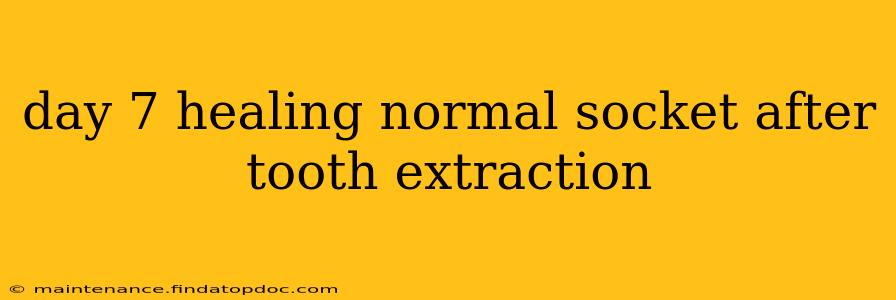Experiencing a tooth extraction can be a bit unsettling, and the healing process naturally brings with it a range of questions and concerns. By day 7, you've likely navigated the initial post-extraction discomfort, but you might still be wondering what's considered "normal" during this phase of recovery. This comprehensive guide will address common post-extraction experiences on day 7 and provide insights into what you can expect. We'll delve into the healing timeline, address common concerns, and offer advice for a smooth recovery.
What Should My Socket Look Like on Day 7?
On day 7, the blood clot that initially formed in the extraction socket should be largely stable. While some minor bleeding or oozing might still occur, especially after rinsing or eating, significant bleeding is not typical. The socket itself will likely appear slightly red and inflamed, but the swelling should be considerably reduced from the initial days following the extraction. A thin, whitish-yellow membrane may be present; this is a sign of healthy healing and shouldn't cause alarm. It's crucial to avoid disturbing the blood clot, as this can lead to complications like dry socket.
Is Some Pain Still Normal on Day 7?
While the most intense pain usually subsides within the first few days, some degree of discomfort or mild aching is still common on day 7. This pain is generally manageable with over-the-counter pain relievers like ibuprofen or acetaminophen, as prescribed by your dentist. However, if the pain is severe, persistent, or worsening, or if you experience any signs of infection (see below), contact your dentist immediately.
What About Swelling and Bruising?
Some swelling and bruising around the extraction site is also expected on day 7, though it should be significantly less than in the earlier days. Applying ice packs intermittently can help manage any lingering swelling. Bruising might still be visible and might even change color (from dark purple to greenish-yellow) as the healing process continues.
Should I Still Be Rinsing My Mouth?
Gentle rinsing with salt water is often recommended for several days after an extraction to help keep the area clean and promote healing. However, avoid vigorous rinsing or using a straw during this time, as these actions can dislodge the blood clot. Day 7 is often the time to transition from frequent rinsing to less frequent but still thorough rinses. Your dentist can give you specific instructions about rinsing frequency and technique.
When Can I Resume Normal Activities?
By day 7, you can usually resume many of your normal activities, but it's important to avoid strenuous exercise, which can increase blood flow to the extraction site and potentially cause complications. Listen to your body; if you feel any pain or discomfort, rest and avoid overexertion. You should also avoid smoking and alcohol, which can impede the healing process.
Is Dry Socket a Concern on Day 7?
Dry socket, or alveolar osteitis, is a painful complication that occurs when the blood clot in the extraction socket is dislodged. The risk of dry socket is highest in the first few days after the extraction, but it can still occur later. If you experience severe, persistent pain, a foul odor or taste, or exposed bone in the extraction site, contact your dentist immediately, as these are signs of a possible dry socket.
What Are the Signs of Infection?
While infections are relatively uncommon after tooth extraction, it's important to be aware of the warning signs. These can include: increased pain, swelling, redness, pus, fever, or chills. If you notice any of these symptoms, seek immediate dental care.
When Should I Call My Dentist After Tooth Extraction?
You should contact your dentist if you experience any of the following:
- Severe or worsening pain: Pain that isn't manageable with over-the-counter medications.
- Excessive bleeding: Bleeding that soaks through multiple gauze pads within an hour.
- Signs of infection: Fever, pus, increased swelling, redness, or chills.
- Dry socket symptoms: Severe pain, bad taste or odor, exposed bone.
Remembering that everyone heals at their own pace, keeping your dentist informed of any concerns is key to a successful recovery. This guide offers general information, and your dentist's personalized advice should always guide your post-extraction care.
